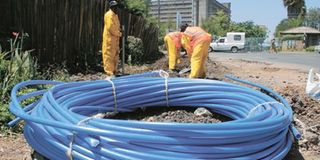Kenya lauded for infrastructural reforms

The undersea and the terrestrial infrastructure is now in place. Photo/FILE
Kenya’s infrastructural reforms have been lauded by the World Bank in a report released on Tuesday, despite broader governance limitations.
“For Kenya, lower scores on the country’s governance indicators have not impeded the achievement of good scores across all utilities’ institutional reforms,” said the report.
Among the areas the country was singled out for reforms included the underwater sea cable and the floating of the KPLC and KenGen shares in the stock market.
Kenya moved forward with its own underwater cable, The East Africa Marine System (TEAMS) with links to the United Arab Emirates.
But it warns that unless the system can be integrated into a regional network, costs will be higher and benefits less broadly shared.
The report entitled Africa’s Infrastructure: A Time for Transformation, took a holistic look at four crucial sectors – energy, water, transport, and ICT – that underpin national economies and are critical for reducing poverty in Africa.
In the energy sector, only Kenya and South Africa have raised much from external capital markets.
The corporatisation of the Kenya Power and Lighting Company and KenGen and the issue of minority shares in the stocks exchange were lauded as a step in the right direction.
However, despite being ahead of most of her peers, the country is still among those who need to sink in a considerable amount of money in to the communication infrastructure to boost her.
The report said Africa has the weakest infrastructure in the world and that in some countries, residents pay twice as much for basic services compared to other people.
Among the identified areas the country still lags behind in were transportation and failure to mitigate climatic extremities.
The report cast doubt on the local road transport, even as it indicates that up to 47 per cent still walk on foot.
“In the early 2000s, nearly 3,000 people were killed on Kenyan roads annually, about 68 deaths per 1,000 registered vehicles, 30 to 40 times the rate in highly motorised countries”.
It added that In Kenya, losses from flooding caused by El Niño in 1997–98 and drought caused by La Niña in 1998–2000 ranged from 10 to 16 per cent of GDP during those years.
The report adds that the concession of the Kenya-Uganda Railways process is smooth, given that it has had difficulties in raising the promised investment financing.
“The drawback of concessions is that they rarely produce the anticipated (and in many cases, contracted) investments for network rehabilitation and expansion”, it reads in part.
Traffic volumes
The reason is that service revenues are too low to support investment finance, partly due to low traffic volumes and intense inter-modal competition and partly due to failure by governments to compensate concessionaires for running loss-making obligatory passenger services.
The World banks also argues that land management institutions could open the door to increased property revenues for municipalities, more land use and sales revenues for the government, and complementary private finance.




